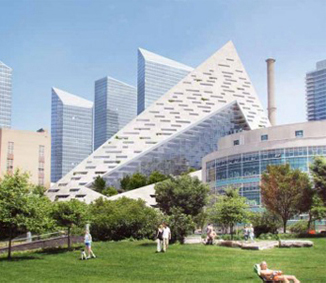Trending
Stimulus for the skyline

Stuart ElliottWith more resilience than one might have anticipated, New York City developers are still thinking outside the glass box.
Pundits said the recession was supposed to mean the death of good architecture in Manhattan, as developers sought to do more “value engineering” on their projects. Fancy design was expected to be the first thing to be eliminated from the budget.
But recent projects — led by 8 Spruce Street, Manhattan’s new tallest residential tower — show that’s not the case. Not only vital for New York’s competitiveness among world cities, this sort of forward-thinking architecture is great news for the real estate world — and for real estate values.
That point was driven home in a webcast we filmed late last month from one of the high floors at the 76-story Spruce Street tower, which just opened to renters, and which, of course, was designed by starchitect Frank Gehry.

8 Spruce Street
Gehry’s design is like nothing else in the New York City skyline. The curves of the steel-skinned building make it look like it’s melting, morphing or flexing (take your pick) right in front of your eyes.
It’s easy to forget that this project stalled for several months in 2009 at 37 stories, and was rescued in part by a citywide labor-saving agreement between the unions, contractors and developers. The agreement shaved 20 percent off construction costs.
In the tough economic times, it would have been easy for developer Forest City Ratner to abandon or significantly curtail Gehry’s plans (there was talk at one point about keeping the building at 37 stories, and Ratner and Gehry famously parted ways on the massive Atlantic Yards project). But the developer stuck with the plan, and it seems a certainty that the project will reap higher rents than it otherwise would have as a result.
Last month also saw the announcement of another game-changing project. The Durst Organization said it would develop a 600-unit, pyramid-shaped residential building on West 57th Street near 12th Avenue, designed by the Danish Bjarke Ingels Group. Another building that is unlike anything else in New York, the squat structure has drawn comments on our website including, “Is that from the movie ‘Inception’?”

A rendering of the West 57th project
One has to imagine a bold design like this by Durst will reap greater financial rewards in the end. In general, the danger isn’t in going too far with design. It’s in not going far enough, as critic James Gardner suggests in his not-so-flattering review of Arquitectonica’s new 42nd Street project.
Sure, apartment buyers do like Robert A.M. Stern-designed buildings such as 15 Central Park West, with their classical contextualism, but you rarely hear of buildings these days that are “too modern” for the market, or that there is a saturation of starchitecture in Manhattan. There seems to be demand for new and adventurous ideas.
Eight Spruce’s opening seems to coincide with a (cautiously) optimistic moment in time — oppressive regimes in the Middle East are being unseated by Facebook-inspired revolutions (which will hopefully end with democratic institutions). And the weight of the crushing economic downturn of the last several years is lifting — which we see in the rebounding commercial market, even if residential is more of a question mark.
New York Times critic Nicolai Ouroussoff said Gehry’s building “crystallizes a particular moment in cultural history … the turning point from the modern to the digital age,” lauding it as “the finest skyscraper to rise in New York” in nearly 50 years.
As the economy rebounds in this digital age, there will be new kinds of economic growth and new kinds of entrepreneurial thinking. And the architecture of a city both reflects that creative thinking and inspires it.
Meanwhile, the enemies, as NYC fights to stay at the forefront of world cities, are the arbiters of stagnation (think Helmsley properties, or landlords you can only reach by fax).
Of course, in addition to daring developers, for all these new buildings to come to fruition, lenders need to take chances as well. Which brings me to one of the main cover stories from the issue, on how lending for commercial real estate is increasing — for refinancing, acquisitions and even development.
At the end of the day, developers, architects, buyers and those who hold the checkbook all have to believe in these game-changing projects for them to happen. Enjoy the issue.

Stuart Elliott




